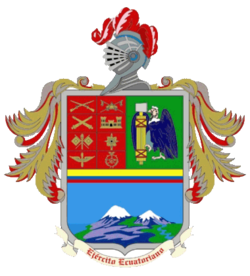Ecuadorian Army
| Ecuadorian Army | |
|---|---|
|
Seal of the Ecuadorian Army
|
|
| Active | 1830 |
| Country |
|
| Type | Army |
| Size | 24,726 active ~130 Tanks ~200 IFV's ~60 aircraft |
| Part of | Military of Ecuador |
| Engagements |
Independence War 1820 Battle of Guayaquil 1860 Ecuadorian-Colombian War 1863 Chincha Islands War 1864 Ecuadorian-Peruvian War 1941 Paquisha War 1981 Cenepa War 1995 |
| Commanders | |
| Current commander |
Patricio Cardenas GRAD. COMANDANTE GENERAL DEL EJÉRCITO ECUATORIANO |
| Notable commanders |
GRAD. Carlomagno Andrade GRAD. Miguel Iturralde GRAD. Paco Moncayo GRAD. Oswaldo Jarrín |
| Insignia | |
| Flag | |
| Roundel | |
Independence War 1820
Battle of Pichincha 1822
Gran Colombia–Peru War 1829
Patricio Cardenas GRAD.
GRAD. Carlomagno Andrade GRAD. Miguel Iturralde GRAD. Paco Moncayo
The Ecuadorian Army (Ejército Ecuatoriano) is the land component of the Ecuadorian Armed Forces. Its 24,726 soldiers are deployed in relation to its military doctrine. The contemporary Ecuadorian Army incorporates many jungle and special forces infantry units into its structure.
To develop territorial-power, in order to accomplish institutional objectives, which guarantee the integrity and sovereignty of the national territory and contribute to the security and development of the nation, as well as to accomplish all objectives indicated by the military strategic planning. ART 26 LEY ORGÁNICA DE LA DEFENSA NACIONAL
To be an institution of the highest level and credibility, systematically integrated, with professional military personnel, orientated on ethics and moral. Capable of adapting itself to new requirements which guarantee peace, security and the nations development.
The Ecuadorian Armed Forces history could start as early as 1531, when civil war ravaged through the Inca Empire. In a key battle near Riobamba, where Huascar's troops were met and defeated by Atahualpa's troops. Atahualpa's final victory over Huascar in the days just before the Spanish conquerors arrived, are seen until today, as a source of national pride. This did not save Atahualpa and his army from total defeat, only a year later at the Battle of Cajamarca against the Spanish conquerors. It would take almost 300 years when Ecuador's struggle for emancipation from the Spanish colonial rule would reach its peak at the Battle of Pichincha. Following a victory, Ecuadorian troops would become part of the Gran Colombian coalition. These were years in which warfare dominated. First, the country found itself on the front lines of Gran Colombias efforts to liberate Peru from Spanish rule between 1822 and 1825; afterward, in 1828 and 1829, Ecuadorian troops would find themselves in the middle of an armed struggle between Peru and Gran Colombia over the location of their common border. After a long campaign the forces of Gran Colombia, under the leadership of Marechal Sucre and Venezuelan General Juan José Flores, proved victorious. The Treaty of 1829 fixed the border on the line that had divided the Quito Audiencia and the Viceroyalty of Peru before independence. By 1859 the nation was on the brink of anarchy. This led to a civil war and the first Ecuadorian-Peruvian conflict. Backed by Guillermo Franco, an Ecuadorian General, the Peruvian army led by General Ramón Castilla arrived in Guayaquil. Accusing Guillermo Franco of treason for signing a treaty with the Peruvians, Gabriel García Moreno, allied with former enemy General Juan José Flores, attacked Franco's forces. After several battles, García Moreno's forces were able to force Franco's troops to retreat back to Guayaquil, the site of the final battle. Ecuadors victory at the Battle of Guayaquil deterred the Peruvians and re-unified the country. Ecuadorian troops would face their greatest challenge and defeat, when in 1941, under controversial circumstances, another Ecuadorian–Peruvian War erupted. A much larger and better equipped Peruvian force, quickly overwhelmed the Ecuadorian forces, driving them back from Zarumilla and invading the Ecuadorian province of El Oro. The government of Ecuador, saw itself forced to accept Peru's territorial claims. Subsequently Peruvian troops withdrew from the invaded El Oro province. However, occasional clashes kept occurring and flared into another outbreak of serious fighting in January 1981 called the Paquisha War, for the control of three watchposts set up by Ecuadorian troops inside a disputed border area. The conflict ceased with the Peruvian Army gaining control of the disputed area. In 1995, Ecuadorian troops would become part of the longest-running source of armed international conflict in the Western Hemisphere when both sides encountered again in the Cordillera del Cóndor. Focus of all fighting would become a small outpost called Tiwintza by the Ecuadorians (and Tiwinza or Tihuintsa by the Peruvians) until the signing of a ceasefire.
...
Wikipedia



